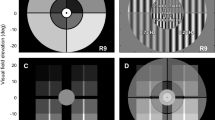Abstract
Purpose
We have previously shown that the amplitude of the mfERG response obtained to a single (large) hexagon is significantly smaller than that obtained when summating all the mfERG responses evoked to an array of 7–61 hexagons covering the same retinal area. The purpose of this study was to confirm our initial findings in normal subjects of different ages and in selected patients.
Methods
Binocular mfERGs (1, 7, 19, 37 and 61 hexagon arrays; Espion V6.0.54 Diagnosys LLC) were recorded from 40 normal subjects (25 aged 18–25, and 15 aged 3–12). Individual mfERG waveforms evoked in response to the multi-hexagon arrays (7, 19, 37 and 61) were summated, and the amplitude of the resulting composite mfERG waveform was compared to that measured in the response evoked to the single (large) hexagon stimulus to yield the amplitude ratio (i.e., 7:1 X100, 19:1X100, etc.).
Results
In normal subjects, the 7:1 ratio was 119.5 ± 9.2%, a value that gradually decreased to reach 109.4 ± 20.6% with the 61:1 ratio and a finding that was similar across all ages.
Conclusion
The present study indicates a significant enhancement in amplitude of the summed mfERG composite waveform evoked to the 7 hexagon stimulus array (and to a lesser extent to the 19, 37 and 61 stimuli) compared to the 1 hexagon array, possibly mediated through the retinal lateral pathway (horizontal or amacrine cells), a claim that awaits confirmation. Preliminary results obtained from patients treated with Plaquenil suggest that this new method of mfERG analysis might probe a feature of macular function different from that investigated with the more usual method of mfERG ring ratio.






Similar content being viewed by others
References
Hood DC, Bach M, Brigell M, Keating D, Kondo M, Lyons JS, Marmor MF, McCulloch DL, Palmowski-Wolfe AM (2012) ISCEV standard for clinical multifocal electroretinography (2011 edition). Doc Ophthalmol 124:1–13
Hood DC, Greenstein VC, Holopigian K, Bauer R, Firoz B, Liebmann JM, Odel JG, Ritch R (2000) An attempt to detect glaucomatous damage to the inner retina with the multifocal ERG. Investig Ophthalmol Vis Sci 41:1570–1579
Kolb H, Fernandez E, Nelson R (eds) (1995) Webvision: the organization of the retina and visual system [Internet]. University of Utah Health Sciences Center, Salt Lake City (UT) [cited 2015 Jun 30]. http://www.ncbi.nlm.nih.gov/books/NBK11530/
McCulloch DL, Marmor MF, Brigell MG, Hamilton R, Holder GE, Tzekov R, Bach M (2015) ISCEV standard for full-field clinical electroretinography (2015 update). Doc Ophthalmol 130:1–12
Sutter EE (1991) The fast m-transform: a fast computation of cross-correlations with binary m-sequences. SIAM J Comput 20:686–694
Hood DC et al (2003) The multifocal electroretinogram. J Neuroophthalmol 23:225–235
Shen Y, Racine J, Little JM, Lachapelle P (2010) Facilitatory interactions evidenced with the multifocal ERG. Investig Ophthalmol Vis Sci 51:1482
Hebert M, Vaegan, Lachapelle P (1999) Reproducibility of ERG responses obtained with the DTL electrode. Vis Res 39:1069–1070
Wassle H, Riemann HJ (1978) The mosaic of nerve cells in the mammalian retina. Proc R Soc Lond B Biol Sci 200:441–461
Fortune B, Johnson CA, Cioffi GA (2001) The topographic relationship between multifocal electroretinographic and behavioral perimetric measures of function in glaucoma. Investig Ophthalmol Vis Sci 78:206–214
Hasegawa S, Takagi M, Usui T et al (2000) Waveform changes of the first-order multifocal electroretinogram in patients with glaucoma. Investig Ophthalmol Vis Sci 41:1597–1603
Mohidin N, Yap MK, Jacobs RJ (1999) Influence of age on the multifocal electroretinography. Ophthalmic Physiol Opt 19:481–488
Hansen RM, Fulton AB (2005) Development of the cone ERG in infants. Investig Ophthalmol Vis Sci 46(9):3458–3462
Hansen RM, Moskowitz A, Fulton AB (2009) Multifocal ERG responses in infants. Investig Ophthalmol Vis Sci 50(1):470–475
Tzekov RT, Gerth C, Werner JS (2004) Senescence of human multifocal electroretinogram components: a localized approach. Graefes Arch Clin Exp Ophthalmol 242(7):549–560
Fortune B, Johnson CA (2002) Decline of photopic multifocal electroretinogram responses with age is due primarily to preretinal optical factors. J Opt Soc Am A Opt Image Sci Vis 19:173–184
Nagatomo A, Nao-i N, Maruiwa F, Arai M, Sawada A (1998) Multifocal electroretinograms in normal subjects. Jpn J Ophthalmol 42:129–135
Dorfman AL, Vatcher D, Sun V, You JY, Beneish R, Khan A, Lachapelle P (2016) Exploring multifocal electroretinography in pediatrics: a story of patients and patience. Doc Ophthalmol 133:9–41
Lyons JS, Severns M (2009) Using multifocal ERG ring ratios to detect and follow Plaquenil retinal toxicity: a review. Doc Ophthalmol 118:29–36
Funding
This study was funded by the Canadian Institutes for Health Research (MOP 126082 to PL), the Research Institute of the McGill University Health Centre (New Direction in Research Grant to ALD, AK and PL) and the McGill Summer Research Bursary Program (CIHR Health Professional Student Research Award to DV).
Author information
Authors and Affiliations
Corresponding author
Ethics declarations
Conflict of interest
The authors have no conflict of interest to declare.
Informed consent
All subjects freely consented to participate in this study, and an informed consent was obtained from all participants (or their parents) included in the study.
Human and animal and rights
This article does not contain any studies with animals performed by any of the authors. All procedures performed on our human participants were done so in accordance with the ethical standards of the Institutional Review Board of the Montreal Children’s Hospital and in accordance with the 1964 Helsinki Declaration and its later amendments or comparable ethical standards.
Additional information
Publisher's Note
Springer Nature remains neutral with regard to jurisdictional claims in published maps and institutional affiliations.
Rights and permissions
About this article
Cite this article
Vatcher, D., Dorfman, A.L., Shen, Y. et al. Revealing a retinal facilitatory effect with the multifocal ERG. Doc Ophthalmol 138, 117–124 (2019). https://doi.org/10.1007/s10633-019-09674-x
Received:
Accepted:
Published:
Issue Date:
DOI: https://doi.org/10.1007/s10633-019-09674-x




